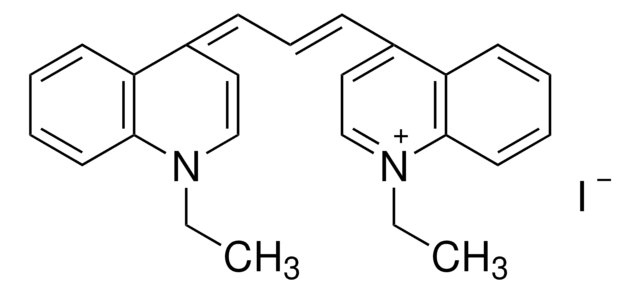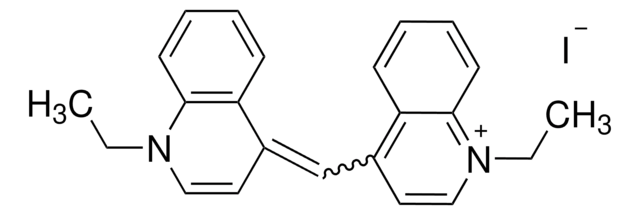323764
1,1′-Diethyl-2,2′-cyanine iodide
97%
Sinônimo(s):
1-Ethyl-2-[(1-ethyl-2(1H)-quinolinylidene)methyl]quinolinium iodide, Decynium 22, Pseudocyanine iodide, Pseudoisocyanine iodide
About This Item
Produtos recomendados
Nível de qualidade
Ensaio
97%
Formulário
powder or crystals
pf
273 °C (dec.) (lit.)
λmax
524 nm
ε (coeficiente de extinção)
≥25000 at 487-495 nm in ethanol
aplicação(ões)
diagnostic assay manufacturing
hematology
histology
temperatura de armazenamento
room temp
cadeia de caracteres SMILES
[I-].CCN1\C(C=Cc2ccccc12)=C\c3ccc4ccccc4[n+]3CC
InChI
1S/C23H23N2.HI/c1-3-24-20(15-13-18-9-5-7-11-22(18)24)17-21-16-14-19-10-6-8-12-23(19)25(21)4-2;/h5-17H,3-4H2,1-2H3;1H/q+1;/p-1
chave InChI
GMYRVMSXMHEDTL-UHFFFAOYSA-M
Categorias relacionadas
Descrição geral
Aplicação
Palavra indicadora
Danger
Frases de perigo
Declarações de precaução
Classificações de perigo
Acute Tox. 2 Inhalation - Acute Tox. 2 Oral - Acute Tox. 4 Dermal - Eye Irrit. 2 - Skin Irrit. 2 - STOT SE 3
Órgãos-alvo
Respiratory system
Código de classe de armazenamento
6.1A - Combustible acute toxic Cat. 1 and 2 / very toxic hazardous materials
Classe de risco de água (WGK)
WGK 3
Ponto de fulgor (°F)
Not applicable
Ponto de fulgor (°C)
Not applicable
Equipamento de proteção individual
Eyeshields, Faceshields, Gloves, type P3 (EN 143) respirator cartridges
Escolha uma das versões mais recentes:
Já possui este produto?
Encontre a documentação dos produtos que você adquiriu recentemente na biblioteca de documentos.
Os clientes também visualizaram
Nossa equipe de cientistas tem experiência em todas as áreas de pesquisa, incluindo Life Sciences, ciência de materiais, síntese química, cromatografia, química analítica e muitas outras.
Entre em contato com a assistência técnica










